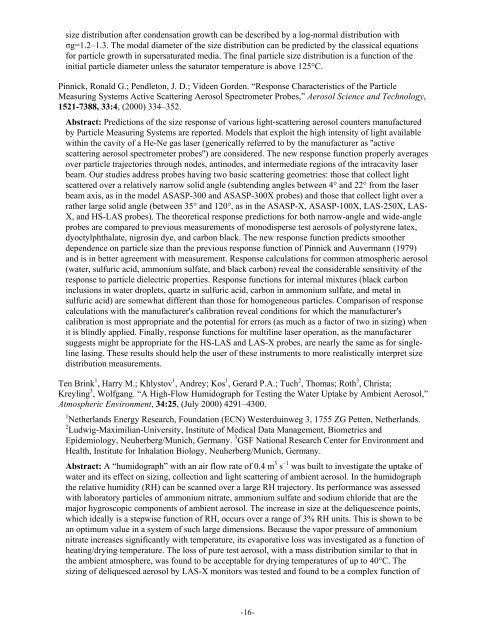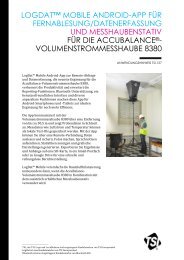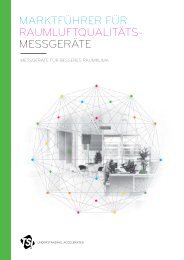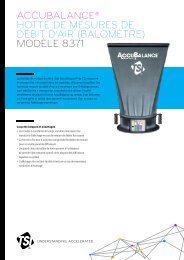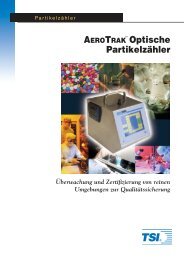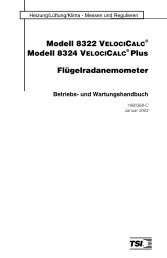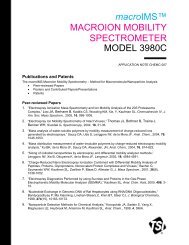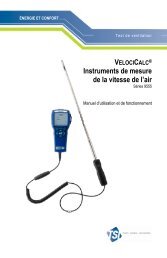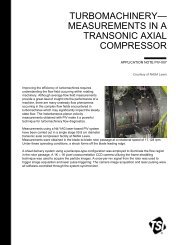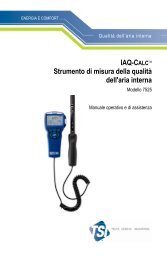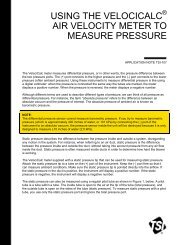Model 3340 Laser Aerosol Spectrometer Bibliography - Tsi
Model 3340 Laser Aerosol Spectrometer Bibliography - Tsi
Model 3340 Laser Aerosol Spectrometer Bibliography - Tsi
Create successful ePaper yourself
Turn your PDF publications into a flip-book with our unique Google optimized e-Paper software.
size distribution after condensation growth can be described by a log-normal distribution with<br />
σg=1.2–1.3. The modal diameter of the size distribution can be predicted by the classical equations<br />
for particle growth in supersaturated media. The final particle size distribution is a function of the<br />
initial particle diameter unless the saturator temperature is above 125°C.<br />
Pinnick, Ronald G.; Pendleton, J. D.; Videen Gorden. “Response Characteristics of the Particle<br />
Measuring Systems Active Scattering <strong>Aerosol</strong> <strong>Spectrometer</strong> Probes,” <strong>Aerosol</strong> Science and Technology,<br />
1521-7388, 33:4, (2000) 334–352.<br />
Abstract: Predictions of the size response of various light-scattering aerosol counters manufactured<br />
by Particle Measuring Systems are reported. <strong>Model</strong>s that exploit the high intensity of light available<br />
within the cavity of a He-Ne gas laser (generically referred to by the manufacturer as ''active<br />
scattering aerosol spectrometer probes'') are considered. The new response function properly averages<br />
over particle trajectories through nodes, antinodes, and intermediate regions of the intracavity laser<br />
beam. Our studies address probes having two basic scattering geometries: those that collect light<br />
scattered over a relatively narrow solid angle (subtending angles between 4° and 22° from the laser<br />
beam axis, as in the model ASASP-300 and ASASP-300X probes) and those that collect light over a<br />
rather large solid angle (between 35° and 120°, as in the ASASP-X, ASASP-100X, LAS-250X, LAS-<br />
X, and HS-LAS probes). The theoretical response predictions for both narrow-angle and wide-angle<br />
probes are compared to previous measurements of monodisperse test aerosols of polystyrene latex,<br />
dyoctylphthalate, nigrosin dye, and carbon black. The new response function predicts smoother<br />
dependence on particle size than the previous response function of Pinnick and Auvermann (1979)<br />
and is in better agreement with measurement. Response calculations for common atmospheric aerosol<br />
(water, sulfuric acid, ammonium sulfate, and black carbon) reveal the considerable sensitivity of the<br />
response to particle dielectric properties. Response functions for internal mixtures (black carbon<br />
inclusions in water droplets, quartz in sulfuric acid, carbon in ammonium sulfate, and metal in<br />
sulfuric acid) are somewhat different than those for homogeneous particles. Comparison of response<br />
calculations with the manufacturer's calibration reveal conditions for which the manufacturer's<br />
calibration is most appropriate and the potential for errors (as much as a factor of two in sizing) when<br />
it is blindly applied. Finally, response functions for multiline laser operation, as the manufacturer<br />
suggests might be appropriate for the HS-LAS and LAS-X probes, are nearly the same as for singleline<br />
lasing. These results should help the user of these instruments to more realistically interpret size<br />
distribution measurements.<br />
Ten Brink 1 , Harry M.; Khlystov 1 , Andrey; Kos 1 , Gerard P.A.; Tuch 2 , Thomas; Roth 3 , Christa;<br />
Kreyling 3 , Wolfgang. “A High-Flow Humidograph for Testing the Water Uptake by Ambient <strong>Aerosol</strong>,”<br />
Atmospheric Environment, 34:25, (July 2000) 4291–4300.<br />
1 Netherlands Energy Research, Foundation (ECN) Westerduinweg 3, 1755 ZG Petten, Netherlands.<br />
2 Ludwig-Maximilian-University, Institute of Medical Data Management, Biometrics and<br />
Epidemiology, Neuherberg/Munich, Germany. 3 GSF National Research Center for Environment and<br />
Health, Institute for Inhalation Biology, Neuherberg/Munich, Germany.<br />
Abstract: A “humidograph” with an air flow rate of 0.4 m 3 s −1 was built to investigate the uptake of<br />
water and its effect on sizing, collection and light scattering of ambient aerosol. In the humidograph<br />
the relative humidity (RH) can be scanned over a large RH trajectory. Its performance was assessed<br />
with laboratory particles of ammonium nitrate, ammonium sulfate and sodium chloride that are the<br />
major hygroscopic components of ambient aerosol. The increase in size at the deliquescence points,<br />
which ideally is a stepwise function of RH, occurs over a range of 3% RH units. This is shown to be<br />
an optimum value in a system of such large dimensions. Because the vapor pressure of ammonium<br />
nitrate increases significantly with temperature, its evaporative loss was investigated as a function of<br />
heating/drying temperature. The loss of pure test aerosol, with a mass distribution similar to that in<br />
the ambient atmosphere, was found to be acceptable for drying temperatures of up to 40°C. The<br />
sizing of deliquesced aerosol by LAS-X monitors was tested and found to be a complex function of<br />
-16-


